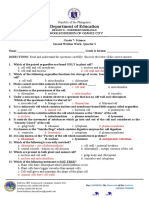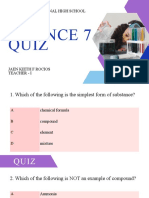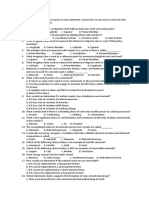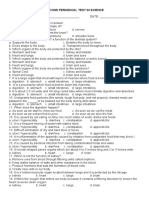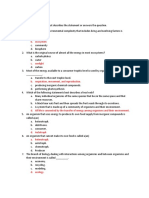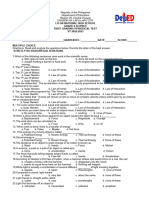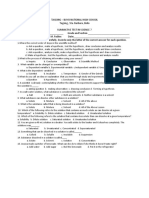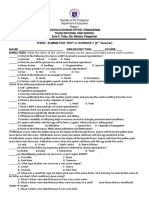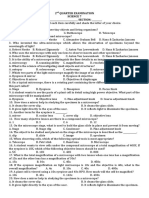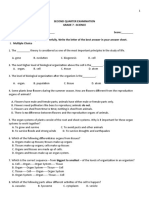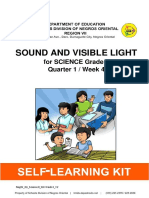Summative Test 2 WEEK 7-8
Summative Test 2 WEEK 7-8
Uploaded by
Cesar Ian RoaCopyright:
Available Formats
Summative Test 2 WEEK 7-8
Summative Test 2 WEEK 7-8
Uploaded by
Cesar Ian RoaOriginal Title
Copyright
Available Formats
Share this document
Did you find this document useful?
Is this content inappropriate?
Copyright:
Available Formats
Summative Test 2 WEEK 7-8
Summative Test 2 WEEK 7-8
Uploaded by
Cesar Ian RoaCopyright:
Available Formats
Quarter 2
SUMMATIVE TEST 2
WEEK 7-8
SCIENCE 7
Name: ________________________________________ LRN: _________________________
Teacher: ______________________________________ Section: ______________________
Score: _________
MELC/S:
● Describe the different ecological relationships found in an ecosystem
● Predict the effect of changes in abiotic factors on the ecosystem
I.Directions: Identify the interaction described in each number by choosing the letter of your answer and
write it in the blank.
_____1. A snake killing and eating a chicken
A. Commensalism C .Mutualism
B. Predation D. Competition
_____2. Carabao eats the grasses found in the field.
A. Predation C. Parasitism
B. Herbivory D. Competition
_____3. A girl is skinny despite eating a lot always because she has worms in her intestine.
A. Predation C. Parasitism
B. Herbivory D. Competition
_____4. Two cats are fighting over a piece of fried fish.
A. Competition C. Parasitism
B. Predation D. Mutualism
_____5. A man feeds and takes good care of a cow while the cow provides milk for the man.
A. Competition C.Parasitism
B. Mutualism D.Herbivory
_____6. The following are abiotic factors that may affect the population of organisms, EXCEPT;
A. Drought C. Predators
B. Earthquakes D. Typhoons
_____7. Wind is an abiotic factor that can affect the distribution and the activities of organisms in several
ways. Many plants depend on wind because__________.
A. Wind keeps branches from growing on the upwind side of the tree
B. Wind moves clouds and rain over Earth’s surface
C. Wind stirs up water in ponds, lakes, and streams
D. Wind helps disperse plants’ pollen and seeds
_____8. If any of the abiotic factor in a certain rice field will be altered or change its condition, what do you
think will happen to the farm?
A. The rice will continue its life.
B. You can still get a good harvest.
C. Crops yield will not be affected.
D. The rice will not grow healthy and eventually die.
_____9. What will happen to a population of cows dwelling in a grassland if all grasses dry-up due to
drought?
A. Cows grow healthy C. Cows eventually die
B. Cows multiply in number D. Cows produce plenty of milk
10. What do you think will happen if the tress in the forest are illegally cut?
A. Animals lost their resources C. Animals grow healthy
B. Plants will multiply in number D. Tress will grow again
_____11. Which of the following abiotic factors may affect the population of organisms?
A. Long drought C. Parasites
B. Food availability D. Predators
_____12. Which abiotic factor has the least effect on the ability of organisms to live in a cave?
A. The amount of energy C. The amount of water available
B. The amount of oxygen D. The shape of the cave
More downloads: https://www.depedtrends.com
_____13. Which of the following abiotic factors that has gradually changed due to pollution and has the
biggest effect to biotic diversity?
A. Water C. Air
B. Climate D. Soil
_____14. Which of the following abiotic factors threatens the stability of our entire planet’s ecosystem?
A. Organisms C. Species
B. Pollution D. Water
_____15. Which of the following experiments is studying the effect of an abiotic factor?
A. Investigating how the amount of precipitation affects the growth of a species of grass
B. Identifying the sources of food for an elephant population
C. Observing the interactions between different fish inhabiting a coral reef
D. Investigating how goats on a mountain compete for food
_____16. A plant needs water, radiant energy, minerals, oxygen, and carbon dioxide to live. How are these
requirements needed by plants categorized?
A. Abiotic components C. Biotic Components
B. Climates D. minerals
_____17. Which of the following represents a biotic components of an ecosystem?
A. Soil C. Sun
B. Sugar Cane D. water
_____18. It refers to the living components of an ecosystem?
A. Climate B. Biotic factors
B. Abiotic Factors D. weather
_____19. It is where organisms live and interact with each other and also with the non-living things.
A. Abiotic C. Biotic
B. Ecosystem D. Organisms
_____20. What are some ways to protect our ecosystem?
A. Do the 3 R’s ( Reuse, Recycle, Reduce)
B. Plant more threes
C. Do not burn your garbage instead segregate it properly.
D. All of the above
_____21. What interaction is displayed when birds lives in the hollow of trees?
A. Parasitism C. Predator-prey
B. Mutualism D. Commensalism
_____22. What ecological relationship is involved when a mosquito sucks the blood of different organisms?
A. Mutualism C. Decomposition
B. Parasitism D. Commensalism
_____23. What ecological relationship is involved in this situation? “A feeder fish usually follows behind
sharks to pick up food and the shark is unaffected.”
A. Mutualism C. Decomposition
B. Parasitism D. Commensalism
_____24. What kind of ecological relationship is involved when a larva of an insect lives on the leaves of the
plant and causes damage by eating the leaves?
A. Mutualism C. Decomposition
B. Parasitism D. Commensalism
_____25. Which of the following defines predation?
A. A relationship between organisms that strive for the same resources in the same place
B. A relationship in which one organism benefits while the other is unharmed
C. A relationship where one organism benefits while the other is eaten
D. A relationship where both organisms benefit from the relationship
_____26. Which of the following represents an abiotic component of the environment?
A. Gliding snail C. Growing grass
B. A pail of water D. Sprouting mongo seeds
_____27. You are told by your science teacher to set up an aquarium as a mini ecosystem. Which of the
following are needed in setting up your aquarium?
A. Fish and water only C. Fish, snails, and plants only
B. Water, sand and light only D. Water, sand, soil and sunlight only
_____28. Which of the following is NOT a biotic component in the ecosystem?
More downloads: https://www.depedtrends.com
A. Rice fields C. Flower garden
B. A waterfall D. Banana plantation
_____29. Which of the following is an abiotic factor that may affect the population of organisms?
A. Prey C. Food Availability
B. Predators D. Extreme temperature
_____30. The following are abiotic components that may affect the population of organisms EXCEPT?
A. Drought C. Predators
B. Typhoons D. Earthquake
_____31. How will you differentiate biotic from abiotic factors in the ecosystem?
A. Both are living things
B. Both are non-living things
C. Biotic are living things while abiotic are non-living things
D. Biotic are non-living things while abiotic are living things
_____32. Which of the following describes biotic components of the ecosystem?
A. It stands still C. It eats dead things
B. It does nothing D. It grows, reproduces and will die
_____33. What will happen to living organisms if their physical environment cannot provide them with their
basic needs?
A. The organisms will grow and develop
B. The population of the organisms will increase
C. The organisms will die and will become extinct
D. The organisms will remain healthy and undisturbed
_____34. Which of the following relationships exhibit mutualism?
A. Algae- fungi C. Rice birds-hawk
B. Rats- cats D. Worms- humans
_____35. What relationship is known whereby one organism benefits and the other is unaffected?
A. Parasitism C. Immigration
B. Mutualism D. Commensalism
II.Directions:.TRUE or FALSE. If the statement is true, write TRUE as your answer. If the statement is
false, write FALSE as your answer.
________1. When an organism eats a part of a plant, the relationship is called parasitism.
________2. In a predation interaction, the one being killed and eaten is called the parasite.
________3. Herbivory is observed in cows that eat grasses.
________4. Humans can be considered as predators.
________5. A parasite is beneficial to its host.
________6. Collaboration is an interaction where two organisms fight for food,
More downloads: https://www.depedtrends.com
ANSWER KEY
I.
1. B
2. B
3. C
4. A
5. B
6. C
7. D
8. D
9. C
10. A
11. A
12. A
13. B
14. B
15. A
16. A
17. B
18. B
19. B
20. D
21. D
22. B
23. D
24. B
25. C
26. B
27. A
28. B
29. D
30. C
31. C
32. D
33. C
34. A
35. D
II.
1. FALSE
2. FALSE
3. TRUE
4. TRUE
5. FALSE
6. FALSE
More downloads: https://www.depedtrends.com
You might also like
- Second Periodic Test in Science G7 17-18No ratings yetSecond Periodic Test in Science G7 17-186 pages
- 1 Summative Test in Science Grade 7: San Pedro Integrated School100% (1)1 Summative Test in Science Grade 7: San Pedro Integrated School2 pages
- Science 7 - Quiz 1 (Pure Substances and Mixtures)No ratings yetScience 7 - Quiz 1 (Pure Substances and Mixtures)28 pages
- Science 7 - Summative Test - Q2 - Week 1-Week 4 - SY 2021-2022No ratings yetScience 7 - Summative Test - Q2 - Week 1-Week 4 - SY 2021-20222 pages
- Q3 ACTIVITY 3.13 Colors of Light - Color of Life!0% (1)Q3 ACTIVITY 3.13 Colors of Light - Color of Life!2 pages
- Science - 7: Unified Summative Assessment (Quarter 2 - Week 1 and 2)No ratings yetScience - 7: Unified Summative Assessment (Quarter 2 - Week 1 and 2)3 pages
- First Written Test in Science 7 QUARTER 4, SY 2021-2022 Instructions: Read Each Question Carefully and Write The Correct Answer in ANo ratings yetFirst Written Test in Science 7 QUARTER 4, SY 2021-2022 Instructions: Read Each Question Carefully and Write The Correct Answer in A6 pages
- Grade 8 Science 1ST Grading Periodical Test Final With Ans Key TosNo ratings yetGrade 8 Science 1ST Grading Periodical Test Final With Ans Key Tos6 pages
- Science: Quarter 1 - Module 3: Elements and CompoundsNo ratings yetScience: Quarter 1 - Module 3: Elements and Compounds18 pages
- Summative Test On Level of Biological Organization100% (1)Summative Test On Level of Biological Organization2 pages
- Grade 7 Science Examination Second QuarterNo ratings yetGrade 7 Science Examination Second Quarter7 pages
- Pisa Like Assessment Inset Output Cindy Mere Mendoza100% (1)Pisa Like Assessment Inset Output Cindy Mere Mendoza3 pages
- Science 7 First Periodic Examination 2022 202350% (2)Science 7 First Periodic Examination 2022 20233 pages
- Science 7 Summative Test With Answer Key Weeks 5-8100% (1)Science 7 Summative Test With Answer Key Weeks 5-82 pages
- Settle3D Analysis Information R-10 - 14+940-15+910 - Drenes-1.8mNo ratings yetSettle3D Analysis Information R-10 - 14+940-15+910 - Drenes-1.8m7 pages
- Chap 3 - Hydraulic Structures - Embankment Dam 1 (Compatibility Mode)No ratings yetChap 3 - Hydraulic Structures - Embankment Dam 1 (Compatibility Mode)7 pages
- Peninsular River System or Peninsular Drainage: Theory 1No ratings yetPeninsular River System or Peninsular Drainage: Theory 14 pages
- Porsopis TamarugoPhil A Native Tree From The Atacama Desert Groundwater Table Depth Thresholds For ConservationNo ratings yetPorsopis TamarugoPhil A Native Tree From The Atacama Desert Groundwater Table Depth Thresholds For Conservation8 pages
- US Geological Survey The Sirte Basin Province of Libya-Sirte-ZeltenNo ratings yetUS Geological Survey The Sirte Basin Province of Libya-Sirte-Zelten33 pages
- Practice Test 13 Ch ọn từ hoặc cụm từ thích hợp (ứng với A hoặc B, C, D) để hoàn thành mỗi câu sauNo ratings yetPractice Test 13 Ch ọn từ hoặc cụm từ thích hợp (ứng với A hoặc B, C, D) để hoàn thành mỗi câu sau6 pages
- Igneous Rocks: (C) Earth, An Introduction To Physical Geology 11 Ed. - Tarbuck, Lutgens, TasaNo ratings yetIgneous Rocks: (C) Earth, An Introduction To Physical Geology 11 Ed. - Tarbuck, Lutgens, Tasa23 pages
- Water Tech A Guide to Investment Innovation and Business Opportunities in the Water Sector 1st Edition William Sarni All Chapters Instant Download100% (1)Water Tech A Guide to Investment Innovation and Business Opportunities in the Water Sector 1st Edition William Sarni All Chapters Instant Download55 pages
- Human Animal and Climate Crisis in Scott-92384877No ratings yetHuman Animal and Climate Crisis in Scott-923848774 pages
- Proposed Activities For "It'S Sci-O' Clock: Scigaw Kalikasan Time"100% (1)Proposed Activities For "It'S Sci-O' Clock: Scigaw Kalikasan Time"1 page
- 1 Summative Test in Science Grade 7: San Pedro Integrated School1 Summative Test in Science Grade 7: San Pedro Integrated School
- Science 7 - Summative Test - Q2 - Week 1-Week 4 - SY 2021-2022Science 7 - Summative Test - Q2 - Week 1-Week 4 - SY 2021-2022
- Science - 7: Unified Summative Assessment (Quarter 2 - Week 1 and 2)Science - 7: Unified Summative Assessment (Quarter 2 - Week 1 and 2)
- First Written Test in Science 7 QUARTER 4, SY 2021-2022 Instructions: Read Each Question Carefully and Write The Correct Answer in AFirst Written Test in Science 7 QUARTER 4, SY 2021-2022 Instructions: Read Each Question Carefully and Write The Correct Answer in A
- Grade 8 Science 1ST Grading Periodical Test Final With Ans Key TosGrade 8 Science 1ST Grading Periodical Test Final With Ans Key Tos
- Science: Quarter 1 - Module 3: Elements and CompoundsScience: Quarter 1 - Module 3: Elements and Compounds
- Summative Test On Level of Biological OrganizationSummative Test On Level of Biological Organization
- Pisa Like Assessment Inset Output Cindy Mere MendozaPisa Like Assessment Inset Output Cindy Mere Mendoza
- Science 7 Summative Test With Answer Key Weeks 5-8Science 7 Summative Test With Answer Key Weeks 5-8
- Settle3D Analysis Information R-10 - 14+940-15+910 - Drenes-1.8mSettle3D Analysis Information R-10 - 14+940-15+910 - Drenes-1.8m
- Chap 3 - Hydraulic Structures - Embankment Dam 1 (Compatibility Mode)Chap 3 - Hydraulic Structures - Embankment Dam 1 (Compatibility Mode)
- Peninsular River System or Peninsular Drainage: Theory 1Peninsular River System or Peninsular Drainage: Theory 1
- Porsopis TamarugoPhil A Native Tree From The Atacama Desert Groundwater Table Depth Thresholds For ConservationPorsopis TamarugoPhil A Native Tree From The Atacama Desert Groundwater Table Depth Thresholds For Conservation
- US Geological Survey The Sirte Basin Province of Libya-Sirte-ZeltenUS Geological Survey The Sirte Basin Province of Libya-Sirte-Zelten
- Practice Test 13 Ch ọn từ hoặc cụm từ thích hợp (ứng với A hoặc B, C, D) để hoàn thành mỗi câu sauPractice Test 13 Ch ọn từ hoặc cụm từ thích hợp (ứng với A hoặc B, C, D) để hoàn thành mỗi câu sau
- Igneous Rocks: (C) Earth, An Introduction To Physical Geology 11 Ed. - Tarbuck, Lutgens, TasaIgneous Rocks: (C) Earth, An Introduction To Physical Geology 11 Ed. - Tarbuck, Lutgens, Tasa
- Water Tech A Guide to Investment Innovation and Business Opportunities in the Water Sector 1st Edition William Sarni All Chapters Instant DownloadWater Tech A Guide to Investment Innovation and Business Opportunities in the Water Sector 1st Edition William Sarni All Chapters Instant Download
- Proposed Activities For "It'S Sci-O' Clock: Scigaw Kalikasan Time"Proposed Activities For "It'S Sci-O' Clock: Scigaw Kalikasan Time"
